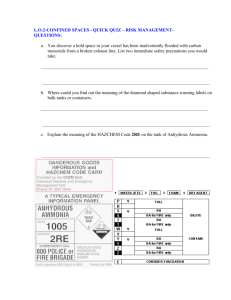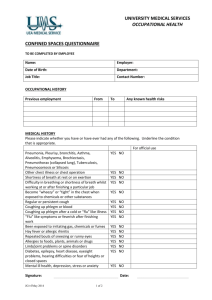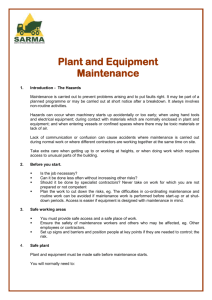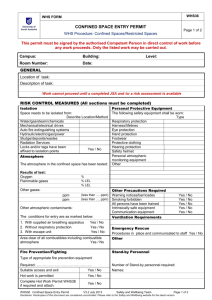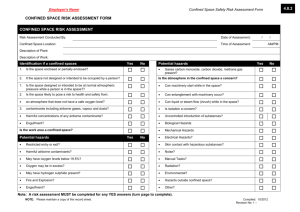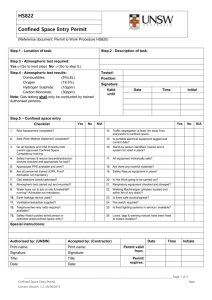Independent School District 196 Confined Space Management Written Program
advertisement
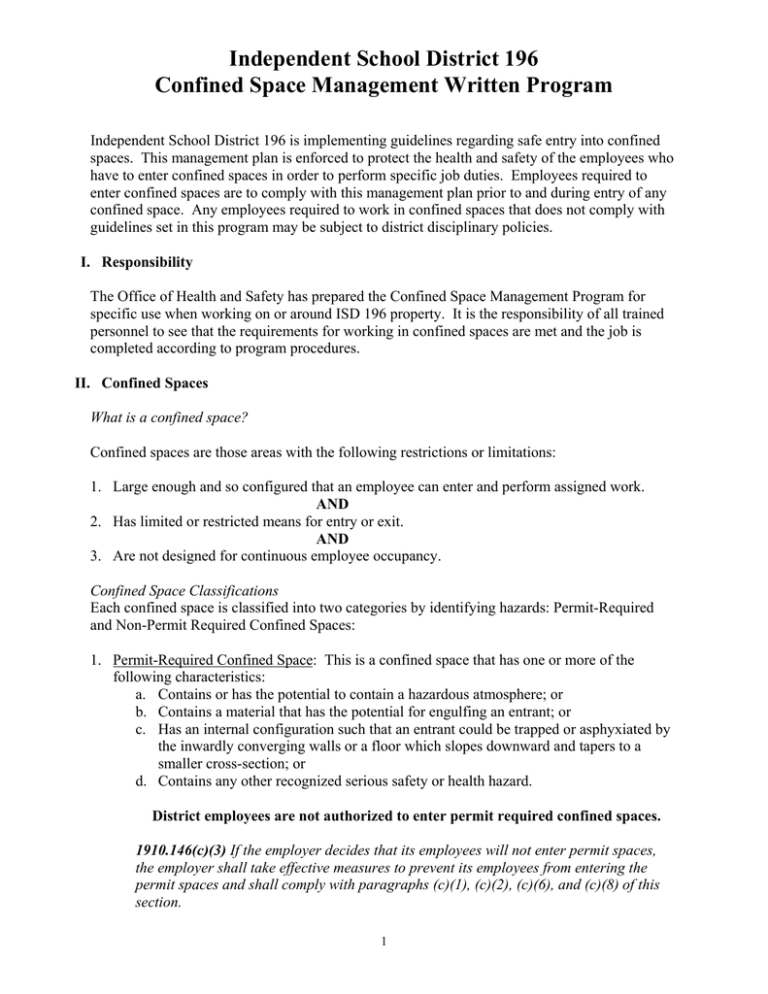
Independent School District 196 Confined Space Management Written Program Independent School District 196 is implementing guidelines regarding safe entry into confined spaces. This management plan is enforced to protect the health and safety of the employees who have to enter confined spaces in order to perform specific job duties. Employees required to enter confined spaces are to comply with this management plan prior to and during entry of any confined space. Any employees required to work in confined spaces that does not comply with guidelines set in this program may be subject to district disciplinary policies. I. Responsibility The Office of Health and Safety has prepared the Confined Space Management Program for specific use when working on or around ISD 196 property. It is the responsibility of all trained personnel to see that the requirements for working in confined spaces are met and the job is completed according to program procedures. II. Confined Spaces What is a confined space? Confined spaces are those areas with the following restrictions or limitations: 1. Large enough and so configured that an employee can enter and perform assigned work. AND 2. Has limited or restricted means for entry or exit. AND 3. Are not designed for continuous employee occupancy. Confined Space Classifications Each confined space is classified into two categories by identifying hazards: Permit-Required and Non-Permit Required Confined Spaces: 1. Permit-Required Confined Space: This is a confined space that has one or more of the following characteristics: a. Contains or has the potential to contain a hazardous atmosphere; or b. Contains a material that has the potential for engulfing an entrant; or c. Has an internal configuration such that an entrant could be trapped or asphyxiated by the inwardly converging walls or a floor which slopes downward and tapers to a smaller cross-section; or d. Contains any other recognized serious safety or health hazard. District employees are not authorized to enter permit required confined spaces. 1910.146(c)(3) If the employer decides that its employees will not enter permit spaces, the employer shall take effective measures to prevent its employees from entering the permit spaces and shall comply with paragraphs (c)(1), (c)(2), (c)(6), and (c)(8) of this section. 1 2. Non-Permit-Required Confined Space: A confined space that does not contain or, with respect to atmospheric hazards, have the potential to contain any hazard capable of causing death or serious physical harm. Reasons for this classification are documented and this information is available to workers entering the space. Pre-Entry Procedures for Non-Permit Confined Space To confirm a safe work environment in a non-permit required confined space, Pre-Entry Procedures are to be used prior to entry. They show the following: The only hazard posed by the space is an actual or potential hazardous atmosphere. That continuous forced air ventilation alone is sufficient to maintain the space safe for the duration of the job. Document supportive data for a non-permit required confined space. Provides current information to employees. Note: Any work that could change conditions in a confined space will require the competent person to re-evaluate the space. Examples of this type or work are: Welding Sodering Other forms of hot work, etc. III. Responsibilities of the Office of Health & Safety The Office of Health & Safety or designated representative shall be responsible for the following: Review and update of the ISD 196 Confined Space Entry Program. Insure compliance with standards set forth in the program by periodic inspection of entry sites and canceling permits where unsafe conditions are present. Assisting with: o Providing training as set forth in the program, o Identification of confined spaces, o Identifying spaces that require a permit for entry, o Labeling Permit-Required Confined Spaces. Perform a single annual review covering all entries performed during a 12-month period to ensure employees participating in entry operations are protected from permit space hazards. Identifying confined spaces within facilities or areas under their control. Identifying hazards within a confined space under their control. Documenting that all training requirements for a specific confined space. Insuring that the required atmospheric tests are performed at the confined space and results recorded on the permit prior to entry authorization. Obtaining and maintaining all equipment necessary to complete the confined-space entry project. IV. Responsibilities of Building Chief The Building Chief or Lead Custodian will be responsible for the following: Assisting in the identification of confined spaces within their facility. Assisting in the identification of hazards, actual or potential, of any confined spaces at their facility. 2 Insuring that all personnel that are required to enter a confined space are trained and understand the hazards. Insuring that all safety equipment is properly working or is properly fixed before use. Any missing or nonrepairable equipment should be brought to the attention of the Office of Health and Safety for replacement. Assist in placing placard signs at the entrances of permit required confined spaces and to insure that signs remain in place. V. Isolation (Lockout/Tagout) In certain situations, it may be necessary to control energy sources (Lockout/Tagout) before any workers are permitted to enter the confined space. This may mean controlling energy sources to the confined space. All energy sources, which are potentially hazardous to the workers in the space, must be secured, relieved, disconnected and/or restrained. VI. Personal Protective Equipment Certain permit entries may require the use of personal protective equipment by workers entering the confined space and/or by rescue teams. A competent person prior to issuing the permit will have determined what equipment is needed. If the permit requires personal protective equipment, all employees entering the space must be equipped with it. The competent person will use the following criteria when determining what types of PPE is required: Head Protection: Is there any danger from falling objects or are there obstructions that could be a bump hazard? Eye and Face Protection: Will workers encounter any irritant dust, vapors, mists, abrasive particles, or flying objects. If so, are safety glasses, impact goggles, chemical goggles or face shields the best choice for the conditions within the space? Hand Protection: Will the workers need protection from sharp edges and rough surfaces? Foot Protection: Will the worker encounter falling objects or corrosive chemicals? Protective Clothing: Will the workers need protection from temperatures, moisture, chemicals, vapors, flames, or electrical. Respiratory Protection: Is there an atmospheric hazard that would exceed OSHA PEL’s or any other hazards that may require respiratory protection. Hearing Protection: If conditions within the confined space require hearing protection, consider how it will affect communications between those workers and the attendant. VII. Contractors ISD 196 employees are not authorized to enter permit-required confined spaces. Work conducted in permitted confined spaces will be contracted out. Contractors are required to follow their company’s Confined Space Program. If the company does not have a program they will be given a copy of the district’s Confined Space Program. Contractors (or their representatives) will be informed of all hazards of that confined space which are reasonably determined. The district will inform them of the permit required confined space program requirements and other applicable safety rules at the facility, as well as those portions of the emergency action place which are applicable to the contractor’s workers. 3
